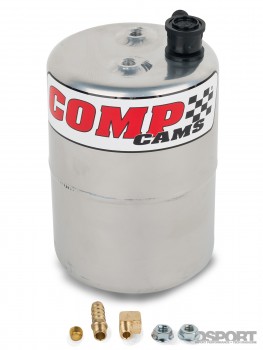There is nothing as unnerving as blasting through the traps at triple-digit speeds only to find that the brake pedal has turned into a cinderblock. If you have ever been in a car that’s lost the assistance of the power brake booster, you know how “rock hard” and uncooperative the brake pedal becomes when the vacuum source is lost to the booster. Vacuum assist is also used on some vehicles to reduce clutch pedal effort too. Unfortunately, installing a set of “big” camshafts in an engine will significantly reduce the strength of the vacuum produced by the engine. The result can be unsafe or at least pain-inducing pedal effort. Fortunately, there is a simple solution.
Text by Richard Fong // Photos by Jun Chen // Illustrations by Paul Laguette
LOW VACUUM, HARD PEDAL
 Vacuum assisted brake boosters serve as a force multiplier, tripling or even quadrupling the amount of pedal pressure applied when stepping on the brake pedal. Typically, the vacuum level should be around 15 inches of mercury (inHg). This amount of vacuum is not usually a problem with stock camshafts set at factory timing. But when cams are chosen to maximize performance, the amount of vacuum produced is often minimal. Why do high-performance cams reduce vacuum? Performance camshaft increase the time that the each valve is open (duration) while also increasing the amount of overlap (when both intake and exhaust valves are open for the same cylinder). While this optimizes cylinder filling at higher engine speeds, it also produces less vacuum. As a result, vacuum-assisted boosters, like those used on the brake system of nearly every modern production vehicle, aren’t able to “assist.” In turn, pedal effort significantly increases and desired brake system hydraulic pressure may never be realized.
Vacuum assisted brake boosters serve as a force multiplier, tripling or even quadrupling the amount of pedal pressure applied when stepping on the brake pedal. Typically, the vacuum level should be around 15 inches of mercury (inHg). This amount of vacuum is not usually a problem with stock camshafts set at factory timing. But when cams are chosen to maximize performance, the amount of vacuum produced is often minimal. Why do high-performance cams reduce vacuum? Performance camshaft increase the time that the each valve is open (duration) while also increasing the amount of overlap (when both intake and exhaust valves are open for the same cylinder). While this optimizes cylinder filling at higher engine speeds, it also produces less vacuum. As a result, vacuum-assisted boosters, like those used on the brake system of nearly every modern production vehicle, aren’t able to “assist.” In turn, pedal effort significantly increases and desired brake system hydraulic pressure may never be realized.


